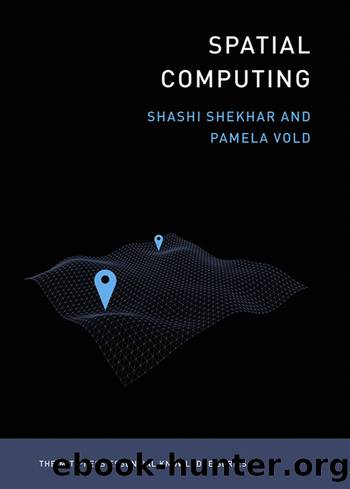Spatial Computing by Shekhar Shashi; Vold Pamela; & Pamela Vold

Author:Shekhar, Shashi; Vold, Pamela; & Pamela Vold [Shekhar, Shashi & Vold, Pamela]
Language: eng
Format: epub
Tags: Spatial Computing, Spatial Data Science, GPS, Global Positioning System, GNSS, GIS, Geographic Information Systems, remote sensing, spatial data mining, spatial databases, spatial database management systems, spatial statistics, maps, digital maps, the science of where, space and location, location science, remote sensors, spatial technology, geographic data, predictive data mining, spatio-temporal computing, Google Maps
Publisher: MIT Press
Published: 2020-02-21T00:00:00+00:00
Figure 11 City of Minneapolis. Source: Minnesota Spatial Computing Group.
Limitations and Concerns
Because GIS is a visualization tool, it can also be used to represent data inaccurately. For example, a tool such as Google Maps will represent a road and will often flag construction sites if that information has been input into its database. However, it does not relay the size or the quality of that road. A rural dirt road may be represented in the same manner as a paved suburban street. There are also concerns about the information that is included on a map. When you are using a mapping tool such as Google Maps to seek out a public space, you will see only certain nearby businesses because they have paid Google a fee to be included in the map. Meanwhile, other public information, such as whether a public park allows dogs or camping, is not displayed. This lopsided presentation raises questions about access to information via these tools—that is, what information is not being relayed due to the monetization of information. We can already see through mapping tools that richer places with more commercial interest are mapped first, while other less economically advantaged but high-density areas (when seen via satellite image) lack mapping.
Maps can be used to intentionally confuse and misrepresent information. We started this chapter explaining how one housing community was effectively gerrymandered out of a flood zone. Political gerrymandering is a great concern in GIS. Partisan gerrymandering of US congressional districts to favor one political party over another has sparked numerous court cases in state supreme courts. Politicians, analysts, and many others still hotly debate the most effective and fair methods of redrawing these congressional districts. Currently in most states, state lawmakers decide how to draw district maps. When partisan lawmakers are in charge of drawing maps, there is an inherent conflict of interest, and we see partisan maps as a result. The maps reinforce the political party in power. In the 2012 federal election, Republicans seized control of the House of Representatives in spite of Democratic House candidates receiving more than 1 million more votes than Republican candidates.
Maps can visually distort information as well. When we look at a map of how each state voted in the 2012 presidential election, with states that supported the Republican candidate, Mitt Romney, in red and states that supported the Democratic candidate, President Barack Obama, in blue, most of the map is visually red. Visually, the maps conveys a win for Mitt Romney because many of the so-called red states are large in area. But these states are low in population, so, for example, the geographic size of Wyoming overrepresents its electoral power (only three votes), while the greater electoral power of the geographically small state of Massachusetts (11 votes) is visually underrepresented in blue. Other choropleth maps can distort information based on interval choices. By grouping a large amount of data in one interval, we can over- and underrepresent data to mislead our audience. The data display choices have a huge effect on how the data that we represent are interpreted.
Download
This site does not store any files on its server. We only index and link to content provided by other sites. Please contact the content providers to delete copyright contents if any and email us, we'll remove relevant links or contents immediately.
| Cryptography | Encryption |
| Hacking | Network Security |
| Privacy & Online Safety | Security Certifications |
| Viruses |
Future Crimes by Marc Goodman(3002)
Mastering Python for Networking and Security by José Manuel Ortega(2951)
Blockchain Basics by Daniel Drescher(2891)
Mastering Bitcoin: Programming the Open Blockchain by Andreas M. Antonopoulos(2511)
From CIA to APT: An Introduction to Cyber Security by Edward G. Amoroso & Matthew E. Amoroso(2483)
Practical Threat Detection Engineering by Megan Roddie & Jason Deyalsingh & Gary J. Katz(2363)
The Art Of Deception by Kevin Mitnick(2298)
Effective Threat Investigation for SOC Analysts by Yahia Mostafa;(2217)
The Code Book by Simon Singh(2210)
Machine Learning Security Principles by John Paul Mueller(1918)
Practical Memory Forensics by Svetlana Ostrovskaya & Oleg Skulkin(1903)
Wireless Hacking 101 by Karina Astudillo(1849)
DarkMarket by Misha Glenny(1847)
Hands-On AWS Penetration Testing with Kali Linux by Benjamin Caudill & Karl Gilbert(1844)
Applied Network Security by Arthur Salmon & Michael McLafferty & Warun Levesque(1840)
Mobile Forensics Cookbook by Igor Mikhaylov(1814)
Serious Cryptography: A Practical Introduction to Modern Encryption by Aumasson Jean-Philippe(1807)
Solidity Programming Essentials by Ritesh Modi(1797)
Bulletproof Android: Practical Advice for Building Secure Apps (Developer's Library) by Godfrey Nolan(1671)
